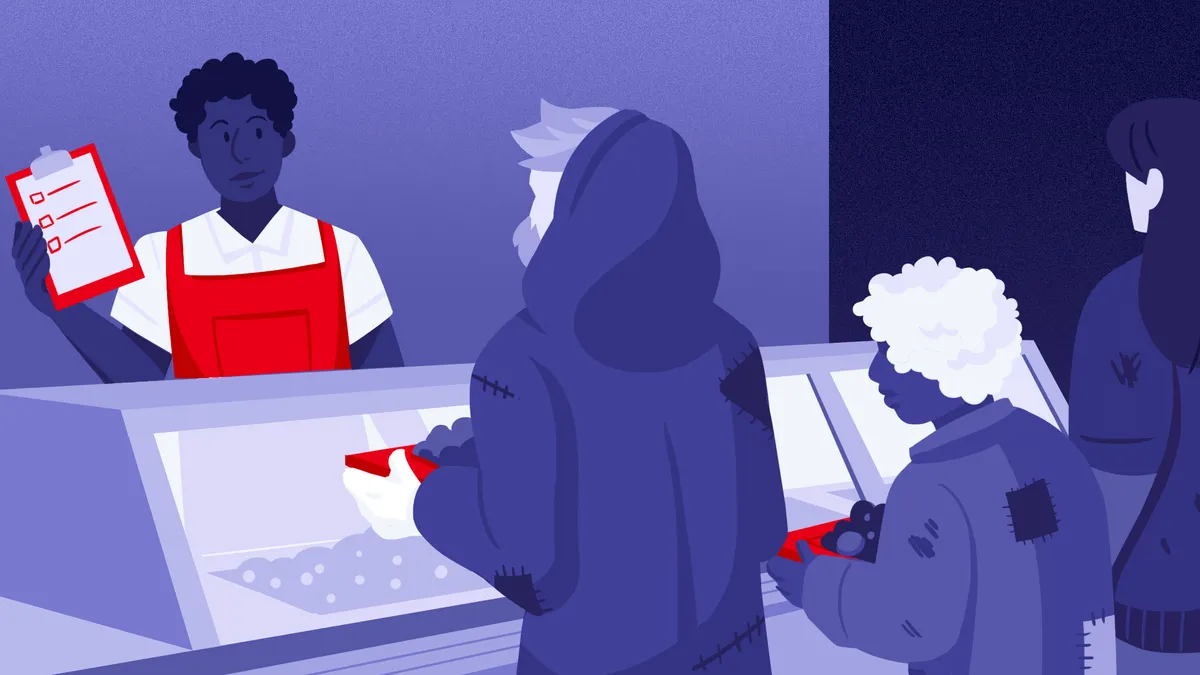An all-hands-on-deck census operation will kick off on March 30 across the country to count people experiencing homelessness.
The three-day operation, or service-based enumeration, is the primary way that cities and census officials count people experiencing homelessness through vists to shelters, soup kitchens, encampments and other targeted locations.
The obstacles to achieving an accurate count of the estimated 3.5 million U.S. residents experiencing homelessness are immense, and people experiencing homelessness have likely been undercounted for decades. Due to the hard-to-count nature of the homeless population, it’s possible this year’s census will yield similar results, which could put billions of dollars of federal funding — which could be used to tackle homelessness — in jeopardy.
Fear and distrust
There are several factors that prevent census workers from achieving an accurate count of people experiencing homelessness. Fear is one of those barriers, and could be heightened this year compared to previous counts, Cara Brumfield, senior policy analyst with the Georgetown Center on Poverty & Inequality, told Smart Cities Dive.
Some individuals experiencing homelessness are hiding from the police or courts, including the one in four individuals experiencing homelessness who have a mental illness and are often jailed instead of being offered treatment or services, according to recent report by Brumfield.
Individuals living in violation of public housing rules may also be afraid that the Census Bureau will share answers with public housing authorities. That fear, however, is misinformed as it is illegal for the Census Bureau to report such activity.
Many people experiencing homelessness also belong to other "hard-to-count" groups. Some of those groups include children, people of color, college students and immigrants. When a person identifies with many of those groups, it can magnify the impact, she said.
"This time around, we have this added layer of anti-immigrant rhetoric on the part of the [Trump] administration and anti-immigrant policies and the proposed citizenship question," Brumfield said. "And all of that… has been increasing the fear and distrust among people of color and among immigrant groups and there’s some overlap with people experiencing homelessness."
'If you don’t have a household, you’re left out'
Other challenges include the transitory status of people experiencing homelessness.
"If you don’t have a household, you’re automatically at a disadvantage," Brumfield said.
In 2016, 68% of people experiencing homelessness lived in emergency shelters, safe havens or transitional housing programs. And in 2015, 31% lived in a car, abandoned building or the street.
"We’ve heard about a huge increase in the number of outdoor encampments," Megan Hustings, managing director of the National Coalition for Homelessness, told Smart Cities Dive.
Those encampments are sometimes "cleaned" or "swept" by cities, making it more difficult to reach those individuals, she said. In previous years, some encampments have also been unlawfully reported to the police following the census count, which can reinforce the mistrust those individuals might feel toward the census.
Experts are also concerned that the U.S. Department of Housing and Urban Development (HUD) uses a flawed methodology to gauge the number of people experiencing homelessness.
In 2019, HUD reported there were 567,715 people experiencing homelessness on a given night. But that data is really just a "snapshot," Hustings said. "It’s not meant to be a true and complete count of people experiencing homelessness."
HUD’s estimation also doesn’t account for the number of people staying with family or friends. That discrepancy can lead to a significant undercount. "The number of people experiencing homelessness that the Census Bureau must reach is likely much higher than HUD estimates," Brumfield wrote in her report.
Getting out the count
To overcome the many barriers that can prevent a complete count of people experiencing homelessness, it is important for local residents to join Complete Count Committees and to help the Census Bureau identify where people experiencing homelessness are within a city, according to Brumfield.
Los Angeles, for example, has been hard hit by homelessness, with about 50,000 people sleeping on its streets at a given time. California is also struggling to keep up with the problem and has experienced a 16.4% increase in homelessness since last year compared to the nationwide increase of 2.7%.
The Los Angeles Homeless Services Authority (LAHSA) is working with the Census Bureau to provide listings of local shelters, meal sites and encampments for individuals to be surveyed and interviewed, Jose Delgado, director of government affairs for LAHSA, told Smart Cities Dive via email.
LAHSA also co-hosted a "hotspot mapping session" with the Los Angeles Bureau Regional Census Office to help the seven LA County Census regional teams gain a clear understanding of the primary encampment sites, he said.
Beyond service based-enumeration efforts, LAHSA is working with city and county officials to pinpoint areas for mobile census kiosks to bring the count "closer to where people are and increase participation."
Internet and computer access is also an issue, especially as this year’s count is primarily taken online for the first time. Libraries can be an essential partner for cities to reach those individuals. The American Library Association is one such organization training staff to help people conduct the count online or become familiar with computers if they aren’t already.
And to reach the people living in transit, an Enumeration at Transitory Location operation is also conducted to count people staying in locations like motels, campgrounds or migrant farm worker camps.
The 'statistical backbone'
An undercount of people experiencing homelessness can have serious ramifications for federal dollars. Funding for child care, education, nutrition and housing programs that support people experiencing (and transitioning out of) homelessness are all affected.
Some of those programs include the $8.3 billion Head Start program that provides grants to local public and private groups for childcare needs and the Runaway and Homeless Youth Program that supports transitional housing and emergency shelter for more than 31,000 young people annually.
Other initiatives include the $69.5 billion SNAP program used by over 40 million low-income families, and the $19.1 billion Section 8 Housing Choice Vouchers Program.
There’s a lot at stake in terms of political influence and financial resources, and the census is a "statistical backbone of research communities," Brumfield said.




















